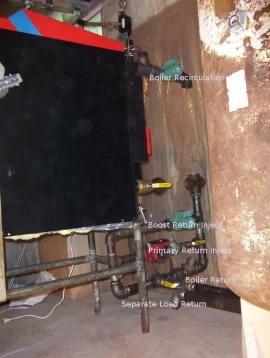I'm Installing a thermosyphon line around my pump that will open in the event of a power loss. How big does that line need to be? The boiler is an EKO 60, 2000 gallons of storage. Figuring that I have enough storage to safely act as my "dump" zone.
It's piped in a way that It should roll into storage pretty good. Boiler to storage loop is 1 1/2", thinking of downsizing for the bypass to reduce the cost of valve, just not sure how far. Would 3/4 be enough? Looking at my fitting pile, I have a 1 1/2 x 1/2, but that seems a little small.
It's piped in a way that It should roll into storage pretty good. Boiler to storage loop is 1 1/2", thinking of downsizing for the bypass to reduce the cost of valve, just not sure how far. Would 3/4 be enough? Looking at my fitting pile, I have a 1 1/2 x 1/2, but that seems a little small.



